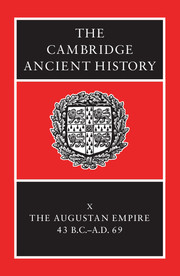9 - The Senate and senatorial and equestrian posts
from PART II - THE GOVERNMENT AND ADMINISTRATION OF THE EMPIRE
Published online by Cambridge University Press: 28 March 2008
Summary
THE SENATE
There can be no question that the 20s B.C. and the half century which followed were a time of unparalleled change for the Senate and its members. Augustus was its principal instigator. Once peace had been secured after the long civil wars, the ‘restoration of the Republic’ was one of his foremost aims. By definition that touched closely the central institutions of the Republic, the Senate among them. The size and quality of senatorial membership engaged his attention first. In size it had expanded to 1,000 or more, partly because of numerous adlections by Iulius Caesar as dictator, partly because following his death others successfully used influence and bribery to gain admission by the same means. Moreover, by raising the total of quaestorships from twenty to forty, Caesar had doubled the number of new members each year, since tenure of this junior magistracy in practice offered life membership of the Senate. As early as 29 B.C. Octavian (as he then was) used a review of the senatorial roll to exclude 190 members on one ground or another. It was probably also during the 20s that he reduced the number of quaestor-ships to the old figure of twenty. Either then, or during the ‘teens B.C., he took the consequential step of reducing the lower office holders (mostly aspirants to the Senate, not yet members) from vigintisexviri (twenty-six) to vigintiviri (twenty).
A Senate of about 800 still seemed too large. When Augustus returned to the task of reducing it further by another review of the roll in 18 B.C., his preference is said to have been for a body of just 300: the simultaneous removal of as many as 500 members would thus be required.
- Type
- Chapter
- Information
- The Cambridge Ancient History , pp. 324 - 343Publisher: Cambridge University PressPrint publication year: 1996
References
- 5
- Cited by



